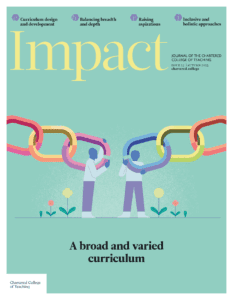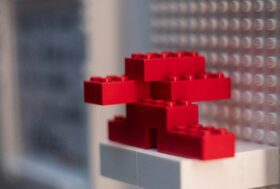Orchestrating the future: Why the arts belong at the heart of a broad curriculum

JAMES CLEMENTS, HEADMASTER OF FOREST PREPARATORY SCHOOL, FOREST SCHOOL, LONDON, UK
Introduction
We often talk about preparing pupils for the future. But in a world shaped by accelerating technological change, evolving career landscapes and complex social and environmental challenges, what does that really entail? The realities that our pupils will face are not fully knowable. In such a context, success depends on more than subject knowledge alone; it requires adaptability, empathy, creativity and the ability to think and work flexibly. The OECD’s Future of Education and Skills 2030/2040 project (OECD, 2018) calls for curricula that prioritise these ‘transformative competencies’ – including resilience, collaboration and creativity, which help young people to shape their world actively and responsibly.
Drawing on current education research, cognitive scienceThe study of the human mind, such as the processes of thought, memory, attention and perception and practice-based evidence, this article argues that embedding the performing and visual arts at the heart of a broad curriculum is one of the most powerful ways to equip pupils for the future.
Why the arts matter: Cognition, creativity and commitment
The value of arts education is widely acknowledged in policy and practice. The Department for Education’s Model Music Curriculum (DfEDepartment for Education - a ministerial department responsible for children’s services and education in England, 2021) highlights the importance of regular, high-quality music education focused on progression, ensemble playing and creativity. Similarly, Ofsted’s subject report on art and design (2023) reinforces the need for well-sequenced, ambitious visual arts teaching. Charitable and sector bodies also champion the role of the arts. Artsmark celebrates schools that place cultural learning at their core, while Music Mark advocates for equitable access to sustained music education. The Education Endowment Foundation (EEF, nd) estimates that arts participation can contribute, on average, an additional three months’ progress in core subjects, while improving confidence and engagement.
Research compiled by the Cultural Learning Alliance (2024) that synthesises multiple arts-based learning projects found that regular participation fosters metacognition, motivation and broader engagement. Their latest evidence shows that arts participation can enhance cognitive ability by up to 17 per cent, with pronounced benefits for pupils from lower-income backgrounds. ‘The arts in schools: Foundations for the future’ report (Tambling and Bacon, 2023) also renewed the national case for embedding the arts in education, arguing that they should be regarded as core to learning rather than peripheral. This aligns with Ken Robinson’s (2006) influential argument that creativity should be considered ‘just as important as literacy’ in education.
These findings tally with what we see in practice. When pupils engage consistently with the arts, they develop concentration, motivation, self-regulation and confidence. As one Year 6 pupil reflected, ‘When I’m in orchestra, I feel like I can solve anything, even when I get it wrong, I want to keep trying.’
The cognitive case for the arts
The arts offer a unique synthesis of cognitive and emotional learning. Integrating music, drama or visual art into the curriculum does not dilute academic rigour – it enriches it. Agarwal and Verma (2023) demonstrated that classrooms incorporating dance, drama and music fostered greater pupil motivation and deeper long-term understanding. Their work points to the embodied, affective and experiential nature of arts learning, factors that promote durable knowledge retention.
This is supported by experimental and longitudinal research in cognitive science. In a two-year randomised controlled trial, Holochwost et al. (2021) found that children aged six to seven who received structured music instruction made measurable gains in executive function, particularly planning and inhibitory control – foundational skills for learning across disciplines. Similarly, longitudinal research in Norway (Osnes et al., 2022) revealed that sustained engagement in an arts-enriched curriculum improved pupils’ self-regulation. While such results are encouraging, their greatest value lies in the way in which they complement what educators observe daily: pupils engaged in the arts learn to focus, to persist and to manage both the precision and ambiguity that creativity demands. These are powerful habits for life and learning.
Embedding the arts: Structure, scale and equity
In practice, what does meaningful arts integration look like? At our school, all pupils in Years 3 to 6 engage in five weekly periods of structured performing and visual arts. Music, music instrumental, dance, drama and visual art are given equal curricular time, reflecting our belief that creativity deserves the same priority as literacy and numeracy. This is not offered as optional enrichment but embedded in the timetable as a universal entitlement. Such an approach ensures consistency, progression and inclusionAn approach where a school aims to ensure that all children are educated together, with support for those who require it to access the full curriculum and contribute to and participate in all aspects of school life, regardless of pupils’ prior exposure, confidence or interests.
A particular area of focus is our instrumental programme. From Year 3, every pupil begins a structured four-year journey with one of 12 orchestral instruments, selected through a rotation and try-out process. Weekly small-group lessons and regular ensemble rehearsals help to develop both musical fluency and transferable capabilities: discipline, attentiveness, perseverance and collaboration. Pupils practise with purpose, respond to feedback and experience the pride of long-term progress.
While this model was developed in the independent sector, the underlying principles – consistent timetabling, inclusive participation and long-term progression – are transferable. Schools in other contexts might draw on partnerships with local Music Hubs or arts organisations to establish similar frameworks. My experience in the maintained sector has shown that with the right leadership and collaboration, arts-rich education can thrive in a range of settings.
The arts do not simply complement the curriculum; they shape it. Weekly dance lessons foster rhythm, coordination, spatial awareness and teamwork. Drama cultivates empathy, confidence and expressive communication. Visual art enhances patience, observation and creativity. Each discipline helps pupils to generate ideas, collaborate and take creative risks. The arts encourage pupils to rehearse and refine their thinking in a tangible, reflective way.
Cultivating creative habits of mind
The Durham Commission (Arts Council England and Durham University, 2019) affirms that all pupils can learn to be more creative, at any stage of education. A 2022 meta-analysisA quantitative study design used to systematically assess the results of multiple studies in order to draw conclusions about that body of research of creativity training in primary schools found consistent, positive effects on originality, idea generation and cognitive flexibility (Sala et al., 2022). At our school, the research of Lucas and Spencer (2017) has been particularly influential. Their five creative habits of mind – inquisitive, persistent, imaginative, disciplined and collaborative – inform how we plan, teach and assess across the arts.
These habits are not exclusive to creative subjects. They support pupils in problem-solving, reasoning and reflection across all areas of learning. Teaching creativity through structured frameworks enables pupils to approach unfamiliar challenges with curiosity, care and confidence – skills that extend far beyond the arts themselves.
Though our curriculum is not explicitly modelled on the OECD Learning Compass 2030, many of its principles resonate strongly with our approach. The Compass emphasises agency, wellbeing and ‘transformative competencies’, such as creating new value, reconciling tensions and taking responsibility (OECD, 2019). Embedding the arts in school life helps to cultivate these dispositions, supporting pupils not only as learners but also as future citizens.
Creative learning is not always easy. As pupils choreograph, rehearse, compose or revise, they experience missteps, feedback and iteration. These moments build what Martin and Marsh (2008) term ‘academic buoyancy’ – the ability to recover from everyday setbacks. Research shows that ensemble work fosters emotional regulation, commitment and teamwork (Putkinen et al., 2024; Saarikallio, 2023).
The full impact of arts-rich education is not always immediately measurable. However, emerging insights from former pupils and families suggest that the creative confidence developed through the arts supports progression in diverse areas, from academic pathways to public speaking, leadership and emotional wellbeing. As an all-through school, we are uniquely placed to observe how these capabilities evolve over time. Longitudinal tracking across key stages reveals that pupils who have experienced sustained arts engagement often demonstrate notable cognitive strengths and resilience, particularly at key examination milestones. Developing more systematic approaches to evaluating these long-term outcomes remains a valuable area for future inquiry.
Conclusion
The arts are not a reward for finishing the real work. They are the real work. They help pupils to make meaning, think critically and express themselves with confidence and care. Far from being decorative, the arts are foundational to rigorous, equitable and future-focused education. School leaders should ensure that creative learning is not an occasional enrichment, but a consistent, high-quality entitlement. Time must be protected for the arts, not just for the benefit of future musicians or artists, but for all pupils, including those who will one day code, campaign, teach, build or heal.
- Agarwal S and Verma M (2023) Integration of performing arts in education: A joyful, retentive and transformative learning. International Journal of Education and Practice 11(2): 98–112.
- Arts Council England and Durham University (2019) Durham Commission on Creativity in Education. Available at: www.artscouncil.org.uk/durham-commission-creativity-and-education (accessed 21 July 2025).
- Cultural Learning Alliance (2024) Key research findings: The case for cultural learning. Available at: www.culturallearningalliance.org.uk/key-research-findings-the-case-for-cultural-learning (accessed 6 August 2025).
- Department for Education (DfE) (2021) Model Music Curriculum: Key Stages 1 to 3. Available at: https://assets.publishing.service.gov.uk/media/6061f833d3bf7f5ce1060a90/Model_Music_Curriculum_Full.pdf (accessed 21 July 2025).
- Education Endowment Foundation (EEF) (nd) Arts participation. Teaching and Learning Toolkit. Available at: https://educationendowmentfoundation.org.uk/education-evidence/teaching-learning-toolkit/arts-participation (accessed 8 April 2025).
- Holochwost SJ, Propper CB, Wolf DP et al. (2021) Music education and the development of executive functions in children: A longitudinal randomised controlled trial. Frontiers in Psychology 12: 660250.
- Lucas B and Spencer E (2017) Teaching Creative Thinking: Developing Learners Who Generate Ideas and Can Think Critically. Carmarthen: Crown House Publishing.
- Martin AJ and Marsh HW (2008) Academic buoyancy: Towards an understanding of pupils’ everyday academic resilience. Journal of School Psychology 46(1): 53–83.
- OECD (2018) Future of Education and Skills 2030/2040. Available at: www.oecd.org/education/2030-project (accessed 8 April 2025).
- OECD (2019) Conceptual learning framework: Learning Compass 2030. Available at: www.oecd.org/content/dam/oecd/en/about/projects/edu/education-2040/concept-notes/OECD_Learning_Compass_2030_concept_note.pdf (accessed 21 July 2025).
- Ofsted (2023) Research review series: Art and design. Available at: www.gov.uk/government/publications/research-review-series-art-and-design/research-review-series-art-and-design (accessed 21 July 2025).
- Osnes B, Holochwost S, Jaffee SR et al. (2022) Arts-based education improves executive function in children. Learning and Instruction 77: 101524.
- Putkinen V, Tervaniemi M and Saarikallio S (2024) Music engagement and socio-emotional development in children: A meta-analytic review. Psychology of Music 52(1): 101–120.
- Robinson K (2006) Do schools kill creativity? TED. Available at: www.ted.com/talks/ken_robinson_do_schools_kill_creativity (accessed 6 August 2025).
- Saarikallio S (2023) Musical engagement as a resource for social and emotional development in childhood. Arts Education Policy Review 124(1): 10–20.
- Sala G, Tatlidil KS and Gobet F (2022) Cognitive and academic benefits of instrumental music training: A meta-analysis. Educational Research Review 35: 100426.
- Tambling P and Bacon S (2023) The arts in schools: Foundations for the future. Calouste Gulbenkian Foundation and A New Direction. Available at: www.culturallearningalliance.org.uk/wp-content/uploads/2023/11/Arts-In-Schools-Executive-Summary.pdf (accessed 21 July 2025).










